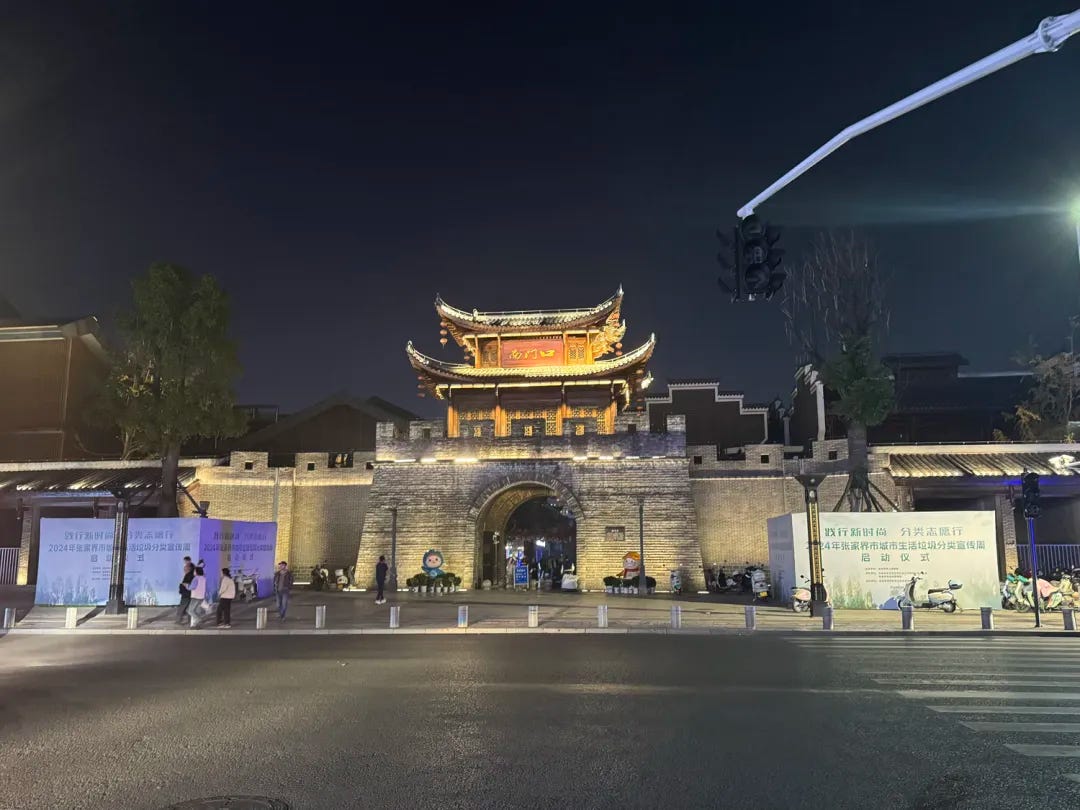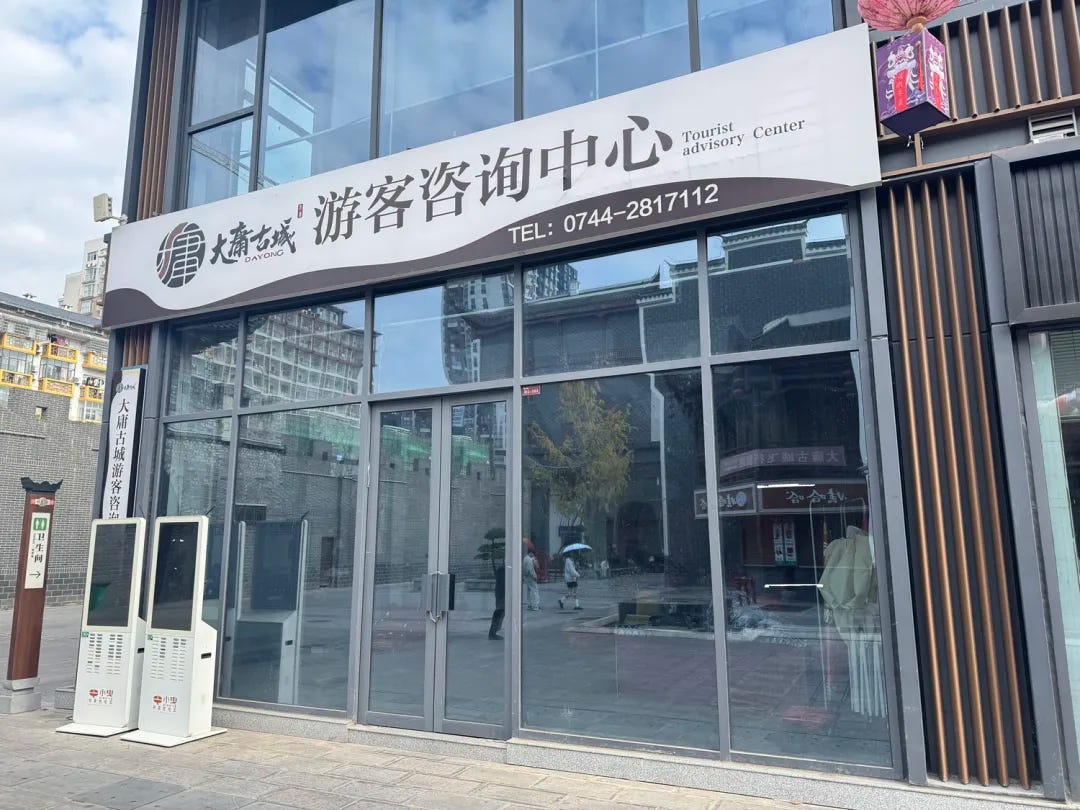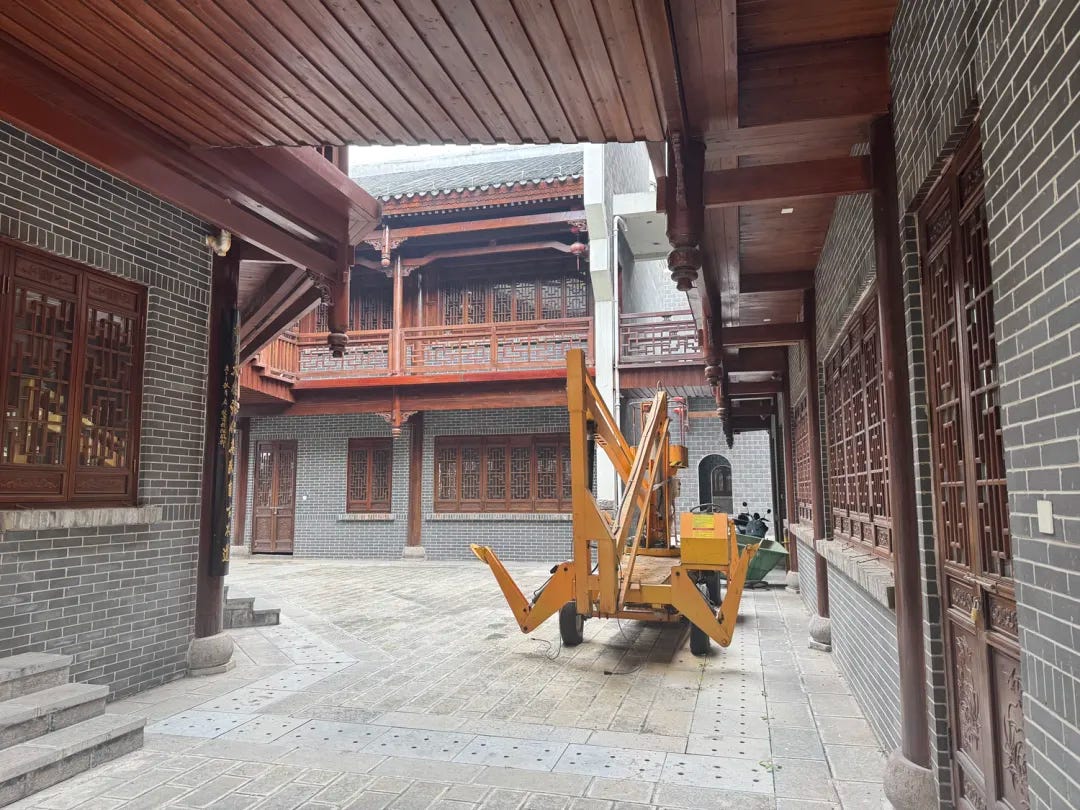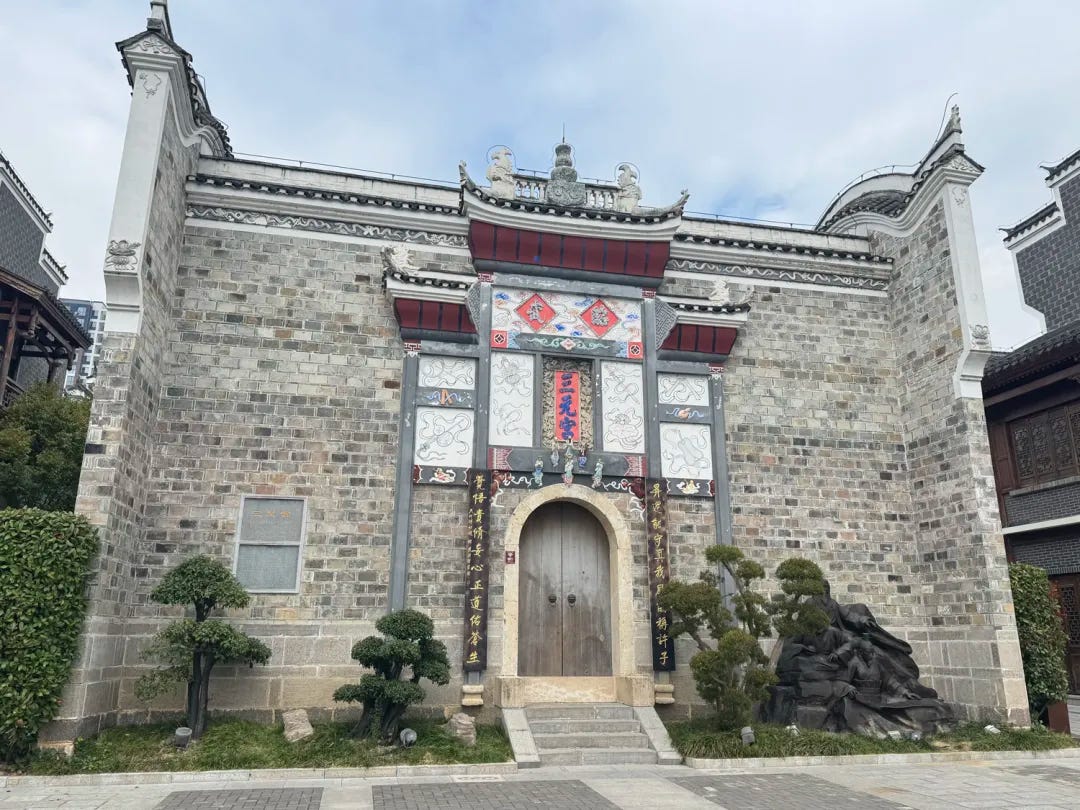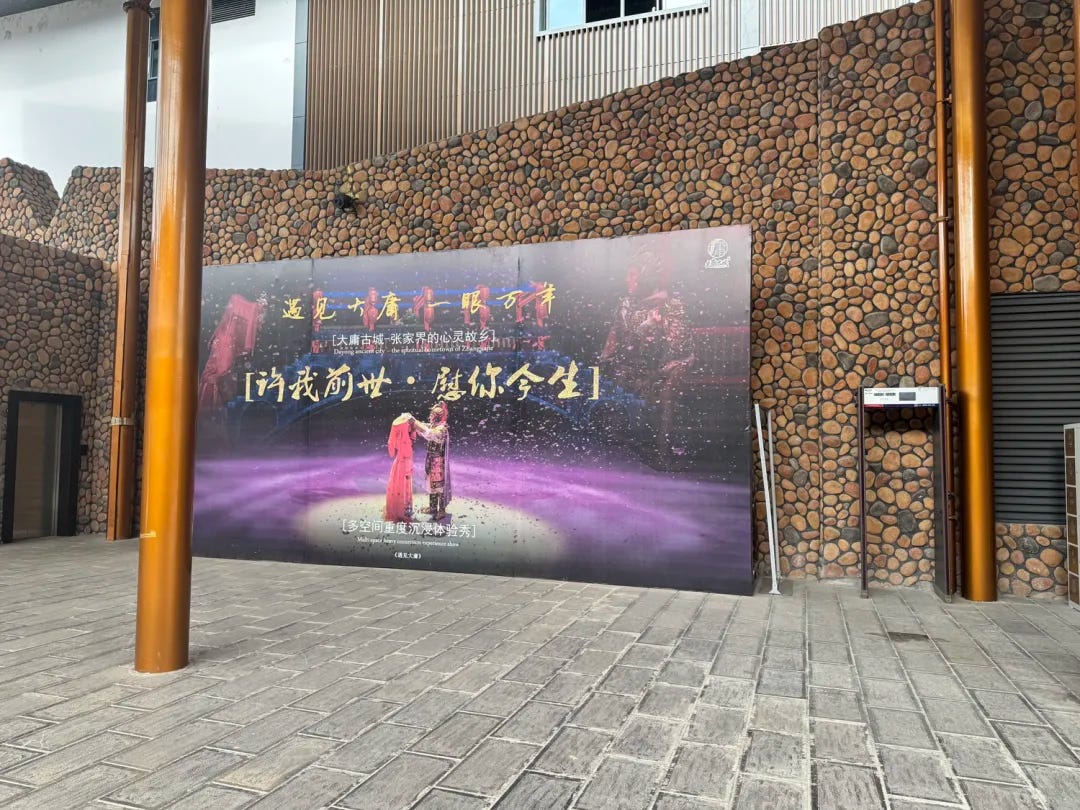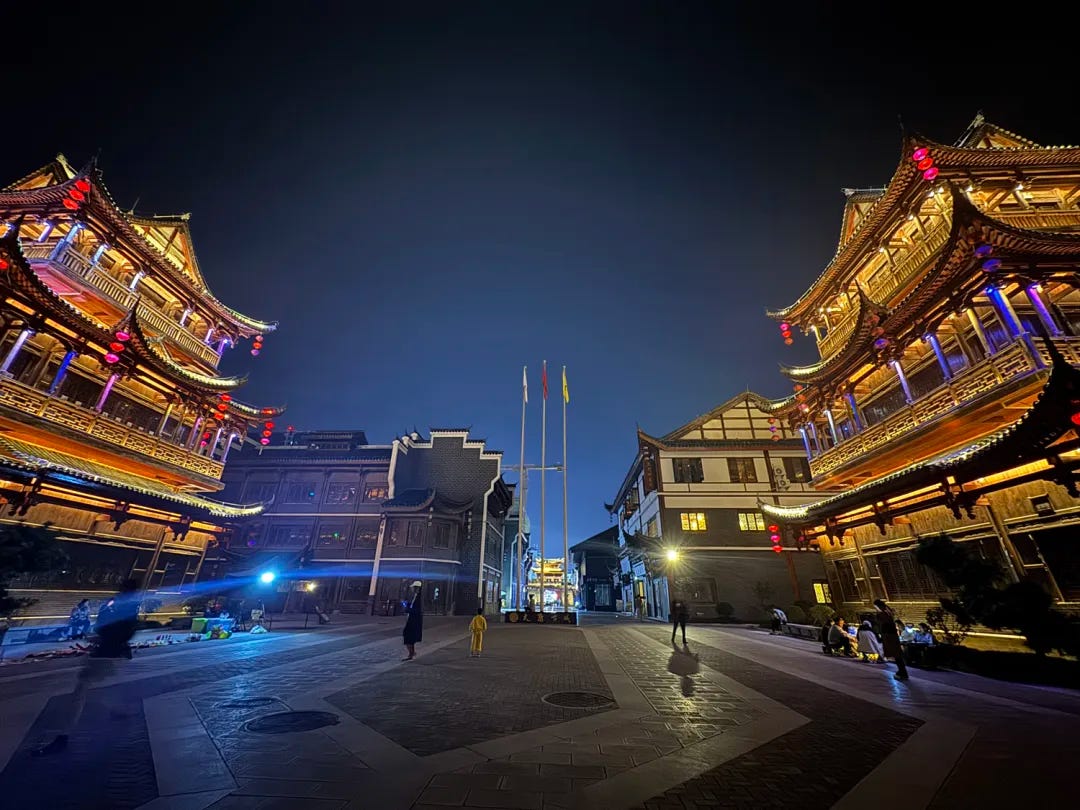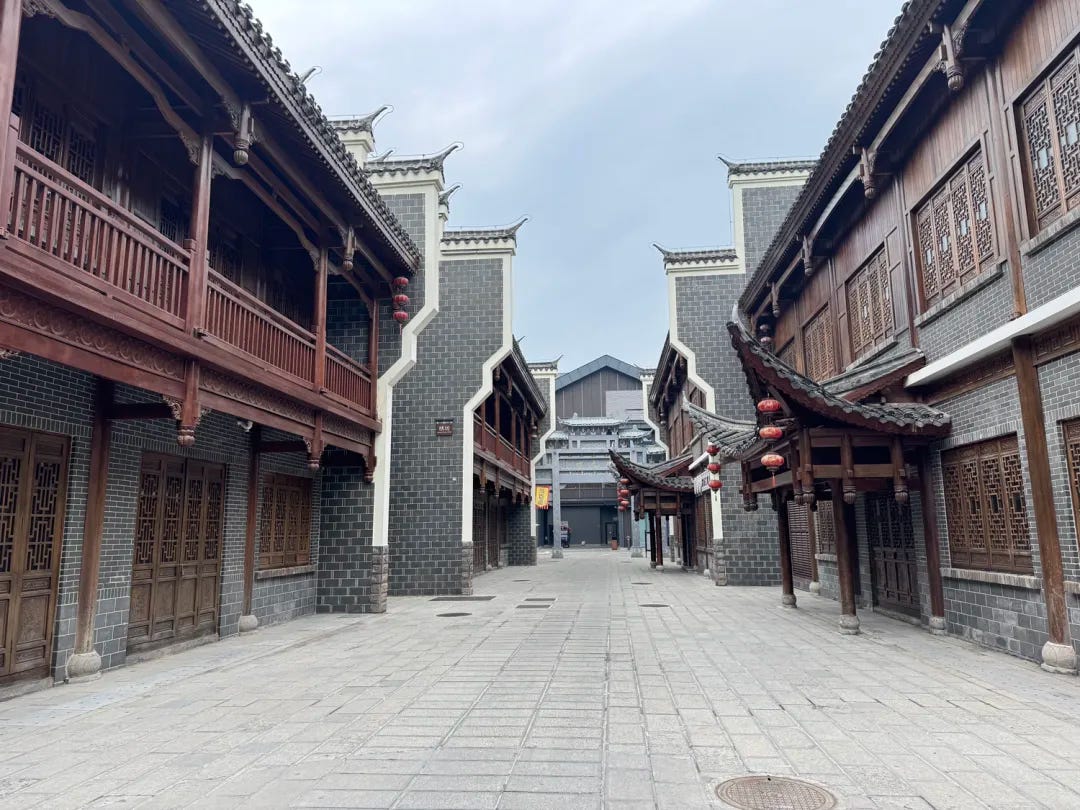A ¥2 billion ghost town: China's oversupply problems in tourism
What 'mass-produced' ancient towns reveal about China's growth model of tourism
Dayong Ancient Town, a tourist destination with 2 billion yuan invested, is now a deserted ghost town.
Tourism has been one of the most vibrant sectors in China since the pandemic, with many travelers turning to ancient towns for a one-of-a-kind experience that connects them to the country’s rich cultural heritage. Towns like Dali, Lijiang, and Wuzhen have seen remarkable success, drawing both domestic and international visitors. But in 2024, a troubling trend has emerged: many ancient towns are facing bankruptcy. Does this mean the growth of the tourism sector is over? Is domestic demand weakening?
Zhang Jia Jie Tourism Group, China’s first publicly listed tourism company, is one of the most prominent casualties of this shift, with its flagship asset, Dayong Ancient Town, contributing heavily to its significant financial losses. Despite efforts to restructure, the company’s struggles raise deeper concerns about the sustainability of the ancient town tourism model in China.
Like other sectors, China’s tourism industry is also facing the problem of “oversupply.”
China now has over 2800 ancient towns, the highest number globally. To put this into perspective, by the end of 2021, there were fewer than 1500 county-level cities in China—meaning that, on average, each county has about two ancient towns.
Many of these towns were developed as part of a 2016 policy initiative by the Ministry of Housing and Urban-Rural Development and other government bodies, aimed at promoting the growth of culturally unique towns for tourism. [source]
However, many of these towns suffer from widespread homogeneity, essentially being "copy and paste" versions of each other, with the same architecture, same street food, and same souvenirs (often made in Yiwu).
Despite initial success, many towns are now facing problems like over-commercialization, lack of uniqueness, and unsustainable growth. As the market becomes flooded with similar towns, many have either failed or turned into "ghost towns" due to poor planning and high maintenance costs.
The reason why the ancient town developed so rapidly is that it can indeed bring considerable economic returns.
Take Wuzhen, one of the most profitable ancient towns, as an example. According to financial reports from its operator, "Zhongqing Travel," Wuzhen received 7.72 million visitors in 2023, generating 1.784 billion yuan in revenue and a net profit of 284 million yuan.
Before large-scale development, Wuzhen was the last town in Tongxiang City, Jiaxing, Zhejiang, to be connected by road.
The success of Wuzhen’s transformation from an ordinary town to a world-class tourist destination has shown many other places the potential of ancient towns to attract visitors. As a result, many have jumped on the bandwagon. Even places with limited funds have adopted the PPP model (Public-Private Partnership), outsourcing development to private capital.
For local governments, developing ancient towns not only creates tourism revenue and provides visible political achievements but also hides a secret agenda: many areas use cultural tourism as a cover to develop real estate, selling land and properties under the guise of cultural projects. [source]
But for other counties that wish to copy and paste the success with ease, the truth is that many of these town developments simply ignored how the market economy works. Large-scale redevelopment has often displaced local residents, removing the authentic, living culture of these places. As a result, these towns have become essentially “fake” ancient towns, lacking the genuine cultural roots that once defined them. Some counties are simply not suited to developing ancient towns due to a lack of cultural and historical heritage, yet they still chose to pursue these projects in an attempt to attract tourists.
Consumers, especially younger generations, have also become more discerning. The mass-produced, copycat ancient towns—while an easy and quick way to replicate initial success—no longer appeal to this more sophisticated market.
A lot of discussions have been surrounding the need for the Chinese government to inject more money and implement fiscal packages to boost the economy. But the real issue is not simply injecting large amounts of money, but rather finding projects that can generate a genuine return on investment.
While the bankruptcy of a single tourism company may not be cause for alarm, its story highlights deeper, systemic challenges within China’s tourism sector and beyond—challenges that reflect broader issues in the country’s economic model and development strategy. By sharing this example with our Baiguan readers, we aim to offer a deeper, contextualized understanding of these widespread issues.
We’ve selected an article that explores how this 2-billion-yuan ancient town, once a thriving tourist destination, has fallen into decline and become a ghost town. Below is our translation of the original article, titled “投资20亿的古城变‘空城’,游客中心灯都没开( A ¥2 billion Chinese ancient town left deserted, with lights off at tourist centers)”
A ¥2 billion Chinese ancient town left deserted, with lights off at tourist centers
By Tang Yingying, Reporter at The Paper
Zhang Jia Jie Tourism Group Co., Ltd. (000430. SZ), China’s first publicly listed company in the tourism sector, now teeters on the brink of bankruptcy.
On October 16, Zhang Jia Jie Tourism Group Co., Ltd. received Decision No. (2024) Xiang 08 Po Shen 12 and Supplementary Decision No. (2024) Xiang 08 Po Shen 12-1, issued by the Zhangjiajie Intermediate People’s Court (hereinafter referred to as the “Zhangjiajie Court”). The applicant, Zhangjiajie Bochen Construction Engineering Co., Ltd., filed a petition with the court seeking bankruptcy reorganization for the company. The Zhangjiajie Court approved the initiation of a pre-restructuring process and appointed Zhang Jia Jie Tourism Group Co., Ltd. as the temporary administrator, tasked with managing all matters related to the pre-restructuring proceedings.
On October 28, Zhang Jia Jie Tourism Group released its third-quarter financial report, reporting revenue of approximately RMB 136 million (≈ $18.6 million), a year-on-year decline of 7.76%, and a net loss attributable to shareholders of the parent company of RMB 3.56 million (≈ $0.49 million), representing a 199% increase in losses year-on-year. For the first three quarters of 2024, the company recorded revenue of approximately RMB 310 million (≈ $42.3 million), down 5.08% year-on-year, and a net loss attributable to shareholders of the parent company of RMB 64.73 million (≈ $8.83 million), a decrease of 53.36% compared to the previous year.
Dayong Ancient Town, a wholly-owned subsidiary of Zhang Jia Jie Tourism Group, was a major contributor to the company’s losses. In the first half of 2024, the subsidiary reported a net loss of approximately RMB 64.38 million ($8.9 million), exceeding the parent company’s total losses for the same period. Had Dayong Ancient Town broken even, Zhang Jia Jie Tourism Group would have recorded a profit.
A recent visit to Dayong Ancient Town by The Paper revealed a desolate scene. Even on weekends, the vast square was nearly empty, with only a handful of street vendors. Inside the tourist area, apart from one milk tea shop and a few small convenience stores, there were no other operational businesses. The commercial spaces surrounding the ancient town remained vacant.
Failed to attract tenants since opening
Dayong, the ancient name of Zhangjiajie, boasts over 2,200 years of history.
In 1985, the Chinese State Council approved the upgrade of Dayong County to Dayong City, and in 1994, the city was renamed Zhangjiajie.
The site of Dayong Ancient Town was once the “South Gate Riverside District,” a central area in Zhangjiajie City near the Lishui River, one of the ‘Four Waters of Hunan.’* With convenient transportation links, the town is less than three kilometers from Zhangjiajie Railway Station.
Baiguan Notes:
The ‘Four Waters of Hunan’ refers to the four major rivers in Hunan Province: the Xiang, Zi, Yuan, and Li Rivers, which flow into Dongting Lake before joining the Yangtze River. These rivers are central to Hunan’s geography and culture.
Zhang Jia Jie Tourism Group Co., Ltd. envisioned transforming Dayong Ancient Town into a cultural and leisure landmark in the city center, integrating dining, accommodation, tourism, shopping, and entertainment. Signature attractions such as ‘The Mysterious Gates,’ ‘Ancient City Time Travel,’ ‘Southern Gate Wharf,’ and ‘Sanyuan Palace’ were designed to serve as key drivers of economic activity.”
However, since its opening, the project has failed to secure sufficient commercial tenants.
During a weekend visit, The Paper found the eastern gate still guarded by two mascots, while the red lanterns atop the city walls were faded and tattered.
Both entrances, the southern and eastern gates, were devoid of staff at their tourist centers. Inside the southern gate’s center, the doors were locked, a sign reading ‘Ticket Inquiry’ lay toppled on the desk, and a promotional pull-up banner was half-collapsed on desks.
The tourist center near the eastern gate, located outside the scenic area, had its doors open but remained unlit. A sign reading ‘Communist Party Member Service Station’ stood at the contion window, while the emergency passageway was cluttered with miscellaneous items.
Entering the scenic area through the eastern gate, one can see ticket machines covered with cloth, now dust-laden. Directional signs have also been moved aside.
Scattered throughout the scenic area are miscellaneous items, construction machinery, and damaged bronze statues.
Aside from rows of faux-ancient buildings, there was little to explore. Signature attractions like Meeting Dayong (an immersive theater show), the flying cinema, and river cruises had ceased operations. Cultural exhibits such as the Sanyuan Palace and a photo gallery dedicated to Marshal He Long were also closed, with even the public restrooms in remote corners of the site locked.
The restaurants in the scenic area were all locked, with only one milk tea shop and a few small convenience stores still open for business. However, the convenience stores saw little activity, and one store clerk was livestreaming on her phone.
Today, Dayong Ancient Town resembles a “community park.” The few “visitors” were mostly local residents walking their pets or bringing their children for an outing.
By nightfall, Dayong Ancient Town transforms into a popular spot for nearby residents to take evening strolls or for young couples to whisper sweet nothings to each other. At the cruise dock, a street performer hosted a ‘concert,’ with the steps leading to the dock crowded with young spectators cheering him on.

The gentle flow of the Lishui River reflected the shimmering lights of the distant Guanyin Bridge. The street performer’s slightly raspy voice sang his favorite pop songs, and now and then, romantic ‘fans’ lit dazzling fireworks behind him. It felt as though there could be no moment more idyllic.

Ironically, while the concert by the Lishui River draws a packed crowd and the bustling city center across the street buzzes with activity, Dayong Ancient Town, situated in between, remains eerily deserted, as if belonging to another world.

Fleeting glory: Meeting Dayong once played four shows a day
Dayong Ancient Town wasn’t always this quiet.
According to The Paper, the scenic spot never charged an entry fee since its opening, but several attractions within the area required tickets. These included the immersive performance Meeting Dayong, the flying cinema experience Flying Over Zhangjiajie, and the Ancient Town Cruise on the Lishui River.
Ticket prices were prominently displayed at the tourist center. A VIP ticket for Meeting Dayong costs RMB 258 per person, while a standard ticket costs RMB 158. The flying cinema charged RMB 65 for regular tickets and RMB 50 for discounts. The river cruise tickets were priced at RMB 88, with a discounted rate of RMB 50.
According to the official WeChat account of Dayong Ancient Town, the full-price ticket for Meeting Dayong was RMB 258 per person, while Zhangjiajie residents could purchase discounted tickets for RMB 100. Similarly, tickets for the flying cinema were priced at RMB 88 for general admission and RMB 38 for local residents.
Currently, tickets are no longer available through Dayong Ancient Town’s WeChat Mini Program.
On social media, content creators who uploaded a six-minute recording of the Flying Over Zhangjiajie experience drew widespread praise, with comments such as “A must-visit!” and “More heartfelt than Disney!”
As promoted on the town’s official account, Meeting Dayong was lauded as Hunan Province’s first multi-space immersive performance. The production involved 120 planners and performers under the Hunan Performing Arts Group, who spent over a year in preparation. With nearly 3,000 square meters of LED screens, cutting-edge stage lighting, and a mobile ride-based viewing system allowing 360-degree seat rotation for a fully immersive and dynamic audience experience.
At its peak, Meeting Dayong was performed up to four times a day. A clerk at a convenience store recalled, “The crowds were huge.” Other store employees confirmed that both the show and the flying cinema had brought in significant foot traffic. However, since both attractions ceased operations, tourist numbers have plummeted. “It’s a real pity,” the vendors lamented.
Today, the flying cinema’s doors remain firmly shut, depriving tourists of the so-called “Zhangjiajie version” of Disney’s Soarin’ Over the World.
At the Meeting Dayong entrance, ticket kiosks and security machines have been relegated to a dusty corner, and a massive promotional poster is now covered in grime. Nearby, a spiral staircase has become a favorite photo spot for older tourists.
No one seemed certain when Meeting Dayong and the flying cinema stopped operating. One shop owner speculated, “They haven’t been open at all this year.” A staff member from Dayong Ancient Town remarked, “It’s been closed for six months, and all the performers have left.”
When The Paper contacted the official phone line of Zhangjiajie City authorities, the respondent said, “We’re just the office; please contact Dayong Ancient Town directly.”
Calls to the town’s listed number resulted in a “number not in service” message, and none of the publicly available phone numbers for Dayong Ancient Town Development Co., Ltd. could be reached.
A destination for elderly tour groups
On a Saturday morning, The Paper counted fewer than ten visitors in Dayong Ancient Town. By the afternoon, the scene had improved slightly, with a handful of individual tourists stopping at the gates to take photos. At its busiest, a tour bus from out of town occasionally dropped off tourists.
The majority of these tour groups consisted of elderly travelers, averaging over 50 years old. A tourist from Fujian told The Paper that their eight-day group tour, including round-trip flights, cost just over RMB 1,000. Another traveler, about 70 years old and from Jiangxi, described Dayong Ancient Town as ‘quite nice, quite nice’.
During interviews, several local residents in Zhangjiajie described Dayong Ancient Town as “all hype and not worth visiting.” One resident remarked, “It’s so quiet. None of us locals go there. It has no commercial vibe, and there’s nothing good to eat.” Others suggested that those interested in faux-ancient architecture would be better off visiting 72 Strange Buildings (Zhangjiajie 72 Qilou).
“72 Strange Buildings is far more impressive than this place. Dayong Ancient Town isn’t even a proper tourist attraction. Only nearby residents come here for a stroll. Tourists would never come,” a local resident told the Paper. “Zhangjiajie is a tourism city. Attractions in the city center usually charge admission, but this place has always been free. If you have time, you should visit 72 Strange Buildings instead.”
By Saturday evening, The Paper observed 72 Strange Buildings with activity. Although it requires an entrance fee, it was packed with tourists. The plaza was filled with people sitting on benches, chatting, and enjoying sunflower seeds while waiting for the evening performances and a bonfire party. Elsewhere in the scenic area, many tourists dressed in traditional costumes for photos.
In stark contrast to 72 Strange Buildings, despite an investment of over RMB 2 billion (approximately $280 million), Dayong Ancient Town remained eerily deserted.
Merchants unite to resist rent payments
An investment exceeding RMB 2 billion (approximately $280 million) was supposed to make a spectacular debut for Dayong Ancient Town. Yet, the ambitious project now faces bleak prospects.
Sources familiar with the matter told The Paper, tenants in the scenic area have refused to pay rent since the town’s opening, paying only a few thousand yuan as deposits. “The merchants claim the project was poorly managed and lacked tourists, so they collectively decided not to pay rent,” one insider revealed.
Data from the 2023 annual report of Zhang Jia Jie Tourism Group Co., Ltd. shows that the rental price for Dayong Ancient Town’s commercial properties was set at RMB 6.87 per square meter per day. When The Paper sought confirmation from shop staff within the scenic area, most employees said they were merely workers and unaware of rental agreements.
An employee at a milk tea shop, which opened alongside Dayong Ancient Town, described the business as ‘okay,’ noting that dine-in and delivery orders were “roughly the same”. “Last month was slightly better, but business has slowed since November,”the employee said.
Meanwhile, a convenience store employee recalled the ups and downs: “Business was fine initially, but then the pandemic hit, and the city went into lockdown. After reopening, the crowds just never returned.”
According to a public filing, Zhangjiajie Bochen Construction Engineering Co., Ltd. applied for corporate reorganization of Zhang Jia Jie Tourism Group, citing the company’s inability to settle debts and severe insolvency.
Zhang Jia Jie Tourism Group’s showed that as of the end of 2023, the company recorded consolidated current liabilities of approximately RMB 607 million (≈ $83.1 million) and non-current liabilities of RMB 1.21 billion (≈ $165.7 million), against cash and cash equivalents of just RMB 91.19 million (≈ $12.5 million). By June 30, 2024, current liabilities had decreased slightly to RMB 519 million (≈ $71.1 million), but non-current liabilities had risen to RMB 1.247 billion (≈ $170.6 million), with cash reserves shrinking further to RMB 49.89 million (≈ $6.8 million).
On October 28, Zhang Jia Jie Tourism Group announced plans to openly solicit restructuring investors as part of its pre-restructuring and restructuring efforts. The initiative, led by the temporary administrator, aims to enhance the company’s operational sustainability, improve profitability, and protect creditor rights, in accordance with China’s Enterprise Bankruptcy Law.
By November 15, however, a follow-up notice stated that no court decision had yet been received regarding the restructuring application.




